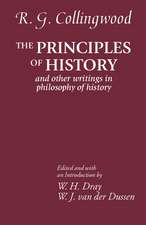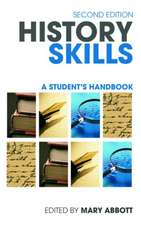Histories on Screen: The Past and Present in Anglo-American Cinema and Television: Bloomsbury Research Skills for History
Editat de Dr Sam Edwards, Dr Faye Sayer, Dr Michael Dolskien Limba Engleză Paperback – 7 feb 2018
Toate formatele și edițiile
| Toate formatele și edițiile | Preț | Express |
|---|---|---|
| Paperback (1) | 194.50 lei 6-8 săpt. | |
| Bloomsbury Publishing – 7 feb 2018 | 194.50 lei 6-8 săpt. | |
| Hardback (1) | 601.11 lei 6-8 săpt. | |
| Bloomsbury Publishing – 7 feb 2018 | 601.11 lei 6-8 săpt. |
Preț: 194.50 lei
Preț vechi: 223.76 lei
-13% Nou
Puncte Express: 292
Preț estimativ în valută:
37.23€ • 40.18$ • 31.21£
37.23€ • 40.18$ • 31.21£
Carte tipărită la comandă
Livrare economică 18 aprilie-02 mai
Preluare comenzi: 021 569.72.76
Specificații
ISBN-13: 9781474217033
ISBN-10: 1474217036
Pagini: 352
Ilustrații: 25 bw illus
Dimensiuni: 156 x 234 x 35 mm
Greutate: 0.5 kg
Editura: Bloomsbury Publishing
Colecția Bloomsbury Academic
Seria Bloomsbury Research Skills for History
Locul publicării:London, United Kingdom
ISBN-10: 1474217036
Pagini: 352
Ilustrații: 25 bw illus
Dimensiuni: 156 x 234 x 35 mm
Greutate: 0.5 kg
Editura: Bloomsbury Publishing
Colecția Bloomsbury Academic
Seria Bloomsbury Research Skills for History
Locul publicării:London, United Kingdom
Caracteristici
Explains the theoretical aspects and practical skills and methods involved in using film as primary and secondary historical source
Notă biografică
Sam Edwards is Senior Lecturer in American History at Manchester Metropolitan University, UK. He has published widely on the cultural history of twentieth century conflict. He is the author of Allies in Memory: World War II and the Politics of Transatlantic Commemoration, c.1941-2001 (2015), which was shortlisted for the Royal Historical Society's Gladstone Prize. Michael Dolski is a historian with the Joint Prisoner of War-Missing in Action Accounting Command's Central Identification Laboratory in the USA. Together with Sam Edwards and John Buckley, he is editor of D-Day in History and Memory: The Normandy Landings in International Remembrance and Commemoration (2014), and he is the author of D-Day Remembered: The Normandy Landings in American Collective Memory (2016). Faye Sayer is Senior Lecturer in Public History and Community Archaeology at Manchester Metropolitan University, UK. She has published extensively on the value of public history and community archaeology, and she is the author of Public History: A Practical Guide (Bloomsbury Academic, 2015).
Cuprins
List of IllustrationsList of ContributorsAcknowledgementsIntroductionPart I: Thinking about Film and Television 1. The Moving Image as Primary Source: Author, Text and Context, Michael Dolski (Defense POW/MIA Accounting Command, USA)2. The Moving Image as a Secondary Source: Truth, Authenticity and Narrative, Faye Sayer (Manchester Metropolitan University, UK)3. The Moving Image as Memory: Past and Present on Screen, Sam Edwards (Manchester Metropolitan University, UK)Part II: Using Film and Television: Case StudiesThe Lens of History: Race, Class and Gender on Screen4. CASE STUDY: 'The Way We Are': Class and Britishness on Film, Marcus Morris (Manchester Metropolitan University, UK)5. CASE STUDY: Were Fires Started? Exploring Gender in British Cinema of the Second World War, Corinna Penniston-Bird (Lancaster University, UK)6. CASE STUDY: Screening Multicultural Britain: Blair, Britishness and Bend it Like Beckham, Sarah Ilot (Teeside University, UK)7. CASE STUDY: Mammy, Mandingo, Django and Solomon: A Century of American Slavery in Cinema from Uncle Tom's Cabin to Twelve Years a Slave, Lydia Plath (Canterbury Christ Church University, UK)Reel Life and Real Life: Documenting and Narrating the Past8. CASE STUDY: The Empire at the Movies: India in Newsreels, c. 1911 to 1947, Tilman Frasch (Manchester Metropolitan University, UK)9. CASE STUDY: 'Truth' and 'Interiority': Screening and Interpreting the Early Modern Era, Jonathan Spangler (Manchester Metropolitan University, UK)10. CASE STUDY: Hollywood Musicals Make History, Nicholas Gebhardt (Birmingham City University, UK)11. CASE STUDY: 'Moving' Images: Educational Uses of D-Day Imagery, Michael Dolski (Defense POW/MIA Accounting Command, USA)Part III: Making Memory and Identity: The Politics and Purpose of Film and TV12. CASE STUDY: Superhero Films and American National Identity, Michael Goodrum (University of Essex, UK)13. CASE STUDY: 'We Will Remember Them?': Film, Television and the First World War in British Memor, Sam Edwards (Manchester Metropolitan University, UK)14. CASE STUDY: Presenting the Past: New Directions in Television History, Nicola Bishop (Manchester Metropolitan University, UK)FilmographyBibliographyIndex
Recenzii
This methodological book can be welcomed within undergraduate courses on the history of film . [It] provides broad introductions to film history through the important lenses of nationalism, production, reception, commemoration, and historical memory.
Each chapter begins with a concise introduction, provides historical and historiographical context before moving into discussion of the particular film or television show, and often ends by exploring the specific material as a source . [This] volume succeeds in providing educators with insights to use in the classroom. Summing Up: Recommended. All levels/libraries.
An accessible overview of core issues and approaches in this area, making it likely to be of interest to a more general readership, as well as scholars looking for an introduction to the way histories of and on screen have been examined and re-examined by historians.
Sam Edwards, Michael Dolski and Faye Sayer are to be congratulated for bringing together such a fascinating set of essays. It is well known that people often understand the past by what they see on the screen, but we often don't stop to consider the processes behind the persuasive effect of film and television. The contributors to this volume bring the complexity of the relationship between consumer and producer of history on screen to light in a lively and engaging manner.
Today most people learn most of what they know about history from films and television. This thoughtful, wide-ranging and stimulating collection of essays explores in depth how and why this is so. An invaluable contribution to our understanding of an often misunderstood cultural phenomenon.
Each chapter begins with a concise introduction, provides historical and historiographical context before moving into discussion of the particular film or television show, and often ends by exploring the specific material as a source . [This] volume succeeds in providing educators with insights to use in the classroom. Summing Up: Recommended. All levels/libraries.
An accessible overview of core issues and approaches in this area, making it likely to be of interest to a more general readership, as well as scholars looking for an introduction to the way histories of and on screen have been examined and re-examined by historians.
Sam Edwards, Michael Dolski and Faye Sayer are to be congratulated for bringing together such a fascinating set of essays. It is well known that people often understand the past by what they see on the screen, but we often don't stop to consider the processes behind the persuasive effect of film and television. The contributors to this volume bring the complexity of the relationship between consumer and producer of history on screen to light in a lively and engaging manner.
Today most people learn most of what they know about history from films and television. This thoughtful, wide-ranging and stimulating collection of essays explores in depth how and why this is so. An invaluable contribution to our understanding of an often misunderstood cultural phenomenon.
















